Menu
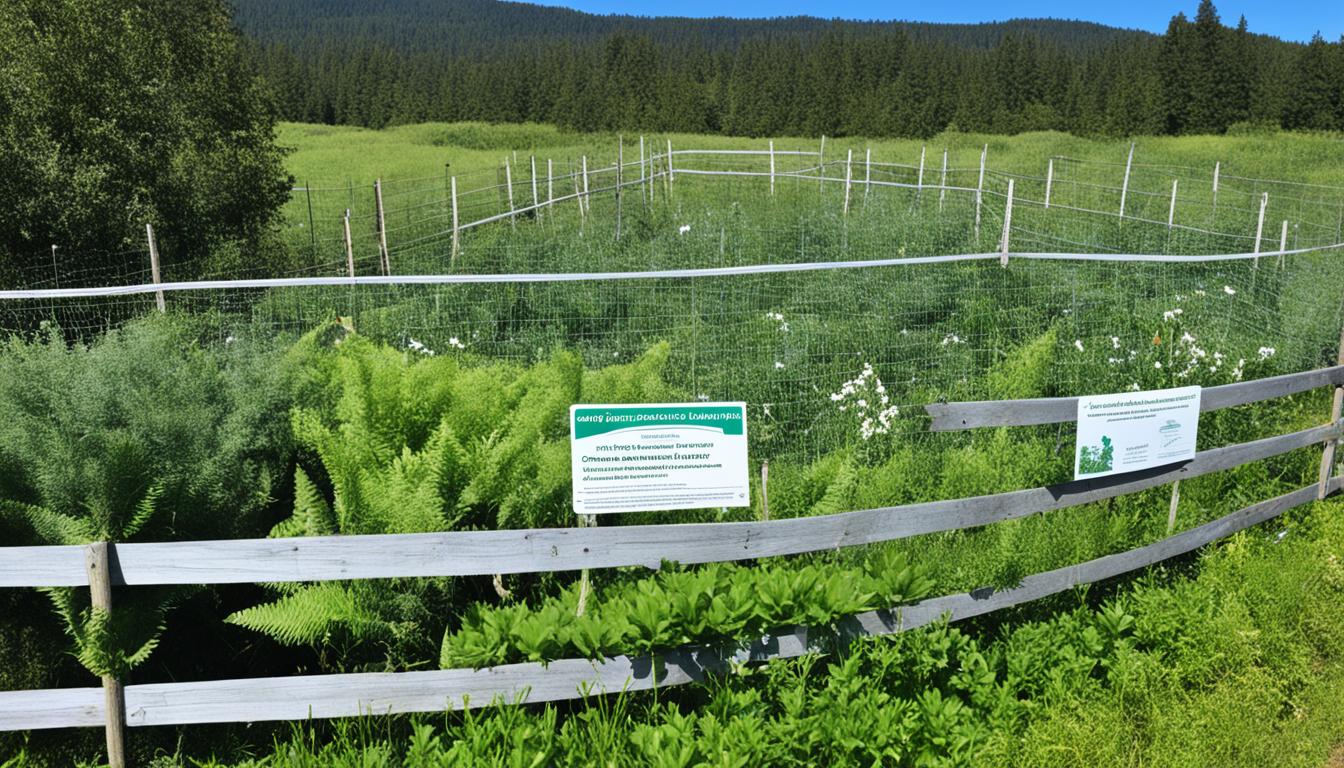
Did you know scientists believe there are at least 8.7 million different types of life on Earth? But, in the last 150 years, farming has drastically reduced the tallgrass prairies in the US to only one percent of their previous size. Knowing about biodiversity laws is key to sustainable farming and helping to reverse these worrying declines.
For farm owners, understanding these laws is very important. They guide us on how to look after our land to keep or boost natural resources like soil and water, and protect the variety of life on our farms. By using practices that fit the land’s specific needs, we help keep nature in balance and increase the variety of life.
Advice from experts at places like the United States Department of Agriculture (USDA) is really helpful. It lets us make detailed plans that follow the rules well. Sticking to these biodiversity principles doesn’t just keep us legal. It also helps our land provide more benefits to nature, showing our care for the environment and sustainable farming.
Exploring these laws and practices further can lead to a more lasting and diverse future for our farms.
Biodiversity conservation laws are key for sustainable farming. They protect a farm’s natural resources like soil, water, and wildlife. These rules help in short-term and long-term ecological health and farming’s future.
These laws cover a wide range of nature, from the ground to water and plant life. They safeguard important areas like wetlands and forests too. This protection creates a better place for farming and wild animals.
Such laws play a vital role in ensuring biodiversity on farms. They help improve the land and support local plants and animals. Following these rules, for example, helps farmers keep a diverse ecosystem through careful planting and protecting natural areas.
In the United States, the USDA’s National Organic Program (NOP) sets the legal foundation for biodiversity conservation. It requires organic farms to maintain or enhance natural resources. These rules cover using safe materials and eco-friendly farming, which all help in protecting biodiversity.
The United States Department of Agriculture (USDA) is at the forefront of promoting biodiversity. It does this through different programmes that aim to keep farming practices in harmony with nature. For example, the National Organic Program (NOP) and the Natural Resources Conservation Service (NRCS) are crucial. They ensure organic farming does not harm the environment but instead supports it.
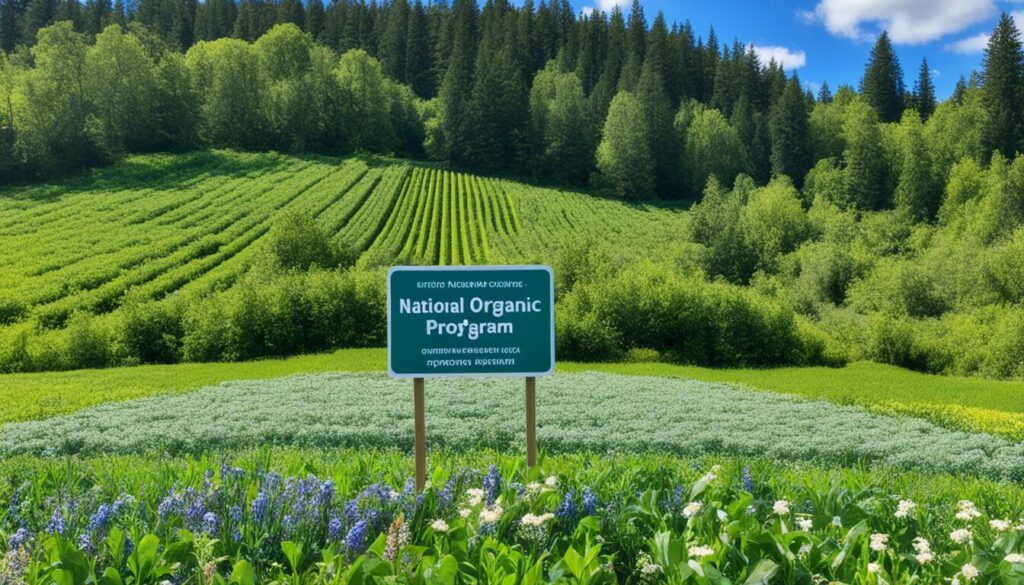
The NOP is a part of the USDA that focuses on organic farming. It lays out strict rules for how organic food should be produced in order to protect the environment. Farmers must follow these rules to take care of the soil and water. By doing so, they keep the land healthy and support a rich variety of plant and animal life.
The NRCS offers help to farmers who want to farm in ways that are good for the land. It provides advice and sometimes money to support environmentally friendly farming. Together with farmers, it works to prevent soil erosion and pollution in the water. These efforts are key to making sure our land can be farmed for generations to come.
The USDA has detailed guidelines for organic farms. These guidelines focus on improving the health of the soil and water. They help farmers reduce the need for chemicals that can harm the land. By following these guidelines, farmers not only meet strict organic rules but also play a vital role in protecting wildlife.
| Programme | Key Focus Areas | Advantages |
|---|---|---|
| National Organic Program (NOP) | Organic certification, natural resource conservation | Ensures ecological balance, supports biodiversity |
| Natural Resources Conservation Service (NRCS) | Technical and financial assistance, conservation practices | Reduces soil erosion, enhances water quality |
| USDA Guidelines | Stop soil erosion, protect water quality | Minimises external input dependency, reduces pest management costs |
In short, the USDA helps farmers look after the environment through its NOP and NRCS programmes. It gives them clear rules to follow and support to farm in ways that protect and nourish our land.
For farms to follow the law, they must use many ways to protect nature. This includes using culture, biology, and machines to take care of the land and its resources.
Keeping the land healthy is key in farming rules. This means farming different crops in fields and picking the best types for the area. It helps the soil stay good and cuts down on plant diseases. The US government’s rules on organic farming say that this keeps farms going in a way that helps nature.
The National Organic Standards Board also agrees. They think it makes sure farms are both lasting and kind to the earth.
Some rules aim to boost the good bugs and stop pests without chemicals. This means attracting bees and other helpful bugs to the farm. Farms that keep to organic rules also cut down on outside fertilisers. This saves money and keeps rivers cleaner. They have to write down a plan that shows how they’ll protect nature, which is a must-do.
Using the right machines can help without hurting the land. Things like no-till farming and smart ways to water are good. They keep the soil strong and use less water. By joining in with the US Natural Resources Service, farms can learn the best ways to look after the land. They also have to check everything is working well by looking at the farm and plans regularly.
| Practice Type | Description | Benefits |
|---|---|---|
| Cultural | Crop rotation, tailored crop varieties | Soil health, pest and disease control |
| Biological | Beneficial insects, organic pest control | Reduced chemical inputs, improved pollination |
| Mechanical | No-till farming, precise irrigation | Soil and water conservation |
Biodiversity laws help farming in many ways. They keep the land healthy and the food supply secure. This also helps farmers use practices that are friendly to the environment.
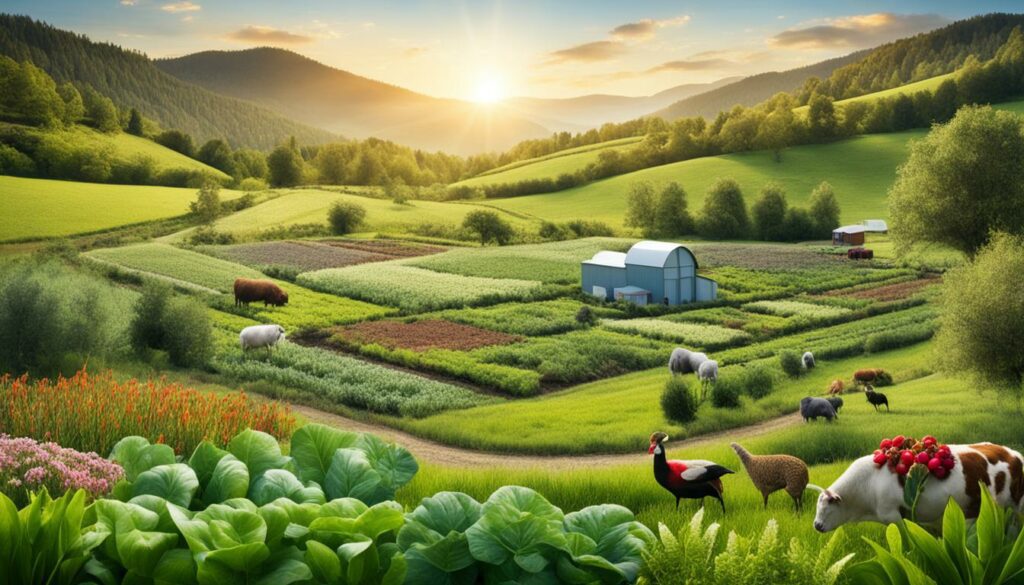
Protecting biodiversity enriches the soil and keeps it fertile. It uses organic matter to keep the soil healthy. This way, farming can avoid causing soil damage and erosion.
A varied ecosystem in the ground helps plants get the nutrients they need. This includes tiny but very important things like microorganisms and fungi.
Diverse farming helps fight off pests and diseases naturally. This means fewer harmful chemicals are used. For example, bats and birds help keep down the bugs.
It also stops diseases from spreading easily among the plants. This is very important as more farms grow just one kind of crop.
Looking after water supplies is key for farming sustainably. Biodiversity knows how to keep water systems working well. This keeps the water clean.
It also helps with water shortages by using the water better. Techniques like not plowing the soil too much and growing various crops help a lot.
| Benefits | Examples | Impact |
|---|---|---|
| Soil Health | Organic matter enrichment, nutrient recycling | Promotes robust plant growth, mitigates erosion |
| Pest Management | Natural predators, disease-resistant crops | Reduces chemical pesticide reliance, eco-friendly |
| Water Management | Wetlands preservation, riparian buffers | Improves water quality, enhances hydrological cycles |
Following biodiversity rules makes many good things happen. The land grows well, and we help protect the planet. It’s good for farming and nature.
Rules for saving natural variety in farming are made at federal and state levels. These rules make sure nature’s health is kept well everywhere.
At the national level, the Endangered Species Act (ESA) guides biodiversity protection farming rules. It says farmers must care for the land and water. This matches with rules for organic farming set by the USDA at 7 CFR 205.200. The National Organic Standards Board (NOSB) suggests checking on biodiversity efforts in organic farming often.
The NOSB wanted more attention on biodiversity starting in May 2009. It asked for stricter checks during inspections by certifiers. This helps cut back on costs for handling pests and needing outside help.
Each state has its own conservation regulations agriculture to fit its nature. They might focus on using local plants in organic farms. Using local plants helps with good bugs, stops soil erosion, and helps refill groundwater. States may add to the national rules to do more for local nature.
Following both national and state rules helps in making a complete plan to save nature. Farmers can get help from the USDA’s Natural Resources Conservation Service (NRCS). This helps them with organic farming plans that are good for soil, water, and the wild. These steps are key in keeping America’s wildlife and nature in good shape.
Creating an Organic System Plan (OSP) is key for getting organic certification. It makes sure your farm follows the rules for nature protection in farming. OSPs detail how you farm, check on things, and stick to what the NOP says. Doing this helps your farm’s natural world stay safe and get better.

An effective organic system plan has several important parts:
For those making or handling food, they need to include six things, like maps and products, for their certificate.
Keeping close watch and records is important for following biodiversity conservation laws farming. You fill in detailed forms so the NOP can check you’re doing it right. Important things to keep track of are:
Producers need to share their OSPs when they apply for certification. This detailed paperwork helps keep to the NOP’s rules and shows you’re open to checks.
Dairy animals need at least a year of organic care before their products can be certified. Ruminants, like cows, must spend a big part of their time on pasture. Making sure to monitor things well is even more important for farmers moving towards organic step by step.
Following these tips and using tools like the Organic Farm Plan helps farms get through the certification process. The USDA and organic groups made these tools together. They can change to fit different needs and help everyone do better in taking care of the land.
It’s key for farmers to know and follow biodiversity conservation laws. This helps them farm in ways that protect nature and meet legal rules. The law comes from both national and local levels to ensure farming helps the environment.
Farmers must stick to biodiversity conservation laws farming. This means doing what their Organic System Plan (OSP) says to protect nature. Certifiers check on their work to make sure it’s right.
The government is putting more money into saving our environment, like the $18 billion in 2022 for farming and nature. Programs like the Conservation Reserve Program have saved many acres of land from harm.
To meet environmental legislation biodiversity protection, farmers should do certain things. They need to create homes for wildlife, take care of their soil, and grow a mix of plants. These not only help the environment but also our health.
Using these good ways of farming is important. They keep farmers following the law and make sure nature benefits. Laws like the Federal Aid in Wildlife Restoration Act and the Dingell-Johnson Act offer money and help. This shows how laws help in many ways to protect our planet.
| Funding Source | Annual Contribution | Purpose |
|---|---|---|
| Farm Bill Conservation Programs | $6 billion (estimated) | Land conservation, habitat preservation |
| Pittman-Robertson Act | $13 million | Wildlife research, habitat protection |
| Dingell-Johnson Act | $10 million | Fisheries management |
Biodiversity laws in farming enhance crop diversification. This step meets conservation regulations agriculture and boosts the farm’s overall health.
Diverse crops stand up better to pests and diseases, lowering economic risks. They also make the soil healthier. Plants like strip cropping and intercropping often yield more.
These diverse systems help more bees to pollinate and cut down on disease, like fungi. This means healthier harvests and less need for chemicals.
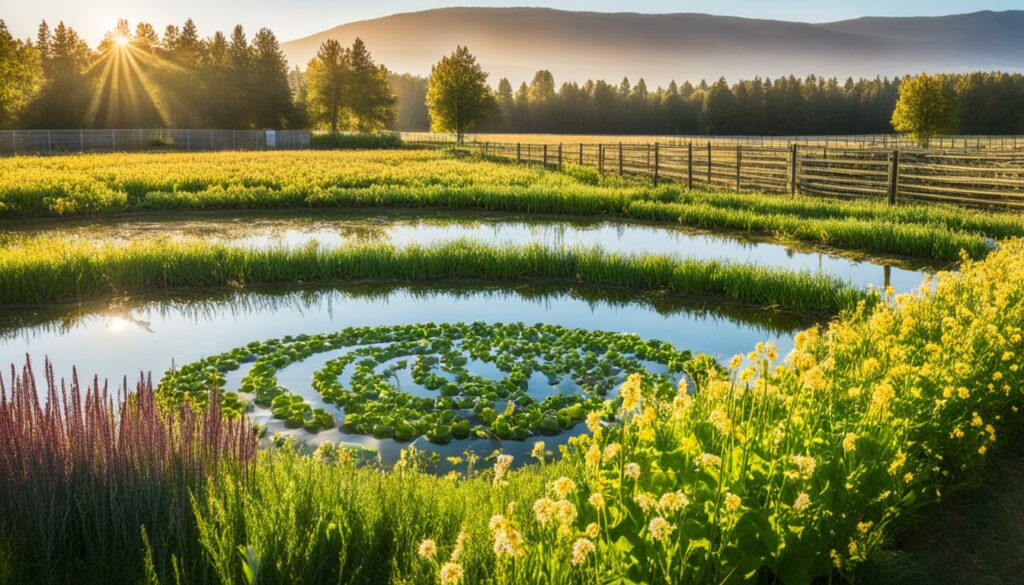
Success stories include mixing trees in with crops (agroforestry systems). This makes soil soak up water better and hold onto it. Adding different animals also helps the land stay healthy.
In the USA, turning lots of grass into farmland from 2015 to 2016 shows we need more crop variety. This kind of change affects balance in nature. Keeping crops mixed can help the land and reduce the need for harmful chemicals.
Such actions help both nature and farming survive for the future. Making a habit of these regulations in farming ensures we all thrive economically and environmentally.
Native species and wildlife corridors are key in biodiversity conservation laws farming. Farms using them help the ecosystem grow and thrive. They follow detailed guidelines that aim to protect nature.
Using native plants and animals creates a healthy, balanced environment. They are adapted to the local area, reducing the need for harmful chemicals and costs for pest control. This approach also leads to better soil and water, which is good for everyone.
Native species help with pollination and keep water clean. These benefits are good for the environment and the economy. They show how nature and farming can work together.
Wildlife corridors are paths that help animals move safely. They are vital for keeping different species healthy and the ecosystem strong. Organic standards highlight their importance, ensuring checks are carried out to meet regulations.
These pathways support the farm’s balance and its natural neighbours, which increases sustainability. Also, farms working with the USDA can get help to build and care for these wildlife highways. This backing makes protecting biodiversity more practical and rewarding.
Handling invasive species well is key to saving natural diversity and meeting farming rules. These invaders can really harm the economy and the habitats. A 2006 report found that aquatic invaders really hurt economic activities.
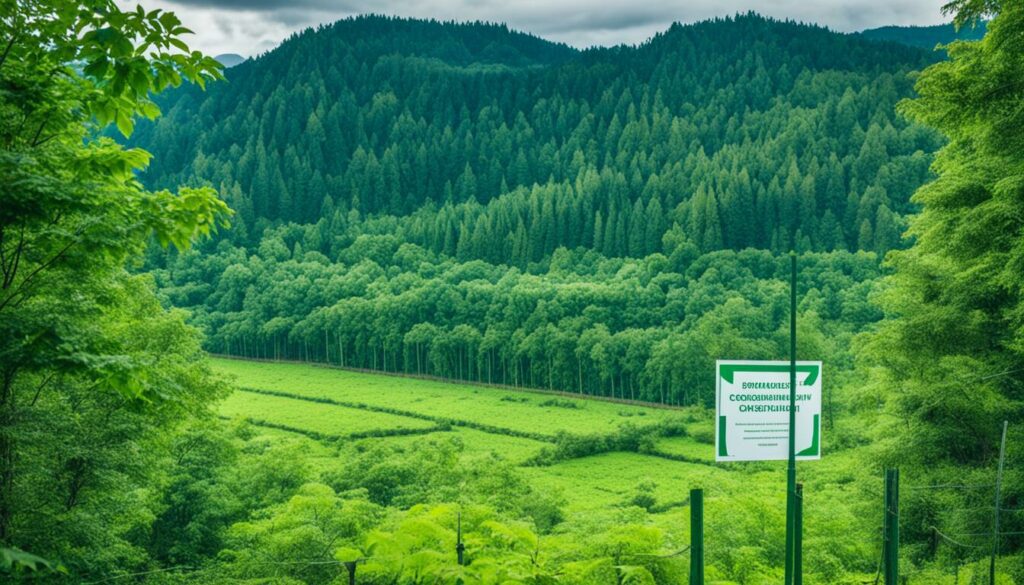
Dealing with invasive species helps keep our local plants and animals safe. It also helps farming practices stay friendly to the environment. Clearing out these troublemakers helps the whole ecosystem thrive and respects the rules on protecting nature.
Spotting invasive species early is crucial. Bugs not normally found in forests, for example, can cause big money losses. We need to spot them by watching for strange bugs or unhealthy plants. They can be treated with chemicals, the sick plants taken out, or by letting their enemies eat them. This way, we keep their numbers low and follow the rules on protecting our nature.
Stopping them before they get a foothold is best. Making habitats healthy again and growing strong ecosystems can stop invaders. Some products are checked and marked as safe from these bad plants, thanks to the NAISMA program. Laws like the Conservation Reserve Program help farms make plans to stop invaders before they strike. These steps are key to keeping our native plants and animals safe and meeting the environmental rules.
Fighting invasive species is important for our farms and nature. By spotting, controlling, and stopping them, we protect the balance of life. This way, farms can help keep our natural world in harmony, following the laws that protect it.
If you’re a farmer keen on using conservation in your farming, it’s great to know about financial aid. The Environmental Quality Incentives Program and other funding sources can really help. They support you financially to meet conservation laws and improve your farm.
The Environmental Quality Incentives Program (EQIP) helps farmers use sustainable practices on their lands. It includes the National Organic Initiative, designed for organic farmers. This initiative supports farmers to follow laws that protect our planet, leading to healthier ecosystems and better farm yields.
There are also state and private options for funding your conservation projects. For example, the Conservation Reserve Program (CRP) gives pay for managing lands in eco-friendly ways. The Agricultural Conservation Easement Program (ACEP) helps protect lands and wetlands through agreements. Moreover, private foundations and agricultural trusts can give grants and support. This further helps meet conservation laws while farming.
| Programme | Benefits |
|---|---|
| EQIP | Financial assistance for integrating conservation practices into working lands |
| CRP | Rental payments for adopting environmentally beneficial land management practices |
| ACEP | Protection of wetlands and working farms through easements |
| Private Funding | Grants and incentives from foundations and agricultural trusts to support conservation efforts |
Joining these programmes helps you keep up with the biodiversity conservation laws in farming. It also makes your farm more sustainable and productive. With the right help, farmers can protect their lands. And, they can also keep their farms profitable.
Putting conservation methods in place on your farm is crucial. This is needed to follow biodiversity conservation laws farming. I’ll share tips that make conservation rules easy to act on. We’ll mainly look at saving water and protecting the soil.
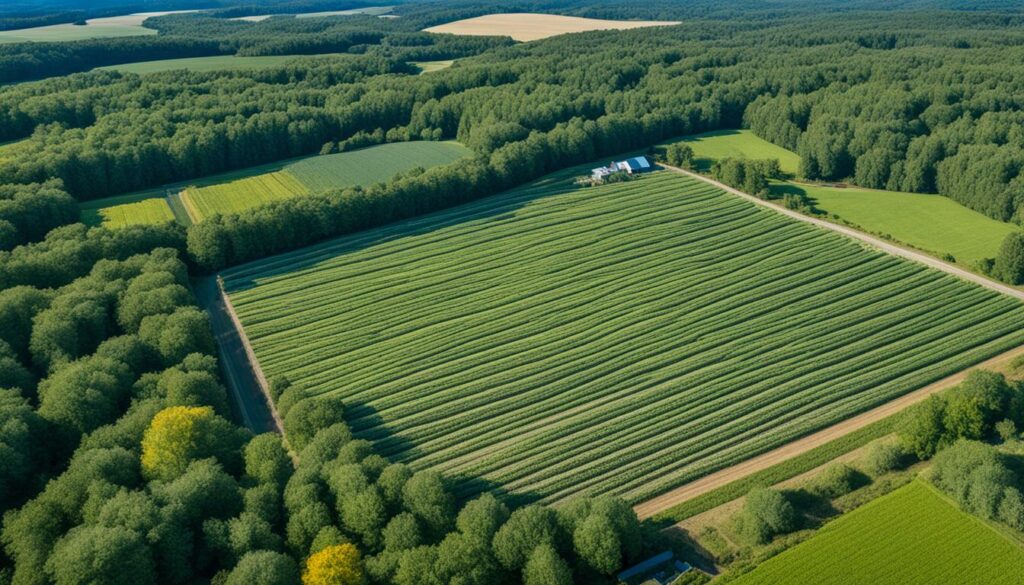
Good soil is key for farming that lasts. Let’s check out how to save soil:
Water matters a lot in farming that takes care of the land. Here are smart ways to use less water:
By using these tricks, you won’t just follow the rules. Your farm will be stronger and kinder to nature over time.
| Conservation Practices | Benefits |
|---|---|
| Cover Cropping | Improves soil health, reduces erosion, increases water infiltration |
| Reduced Tillage | Preserves soil structure, reduces erosion and runoff |
| Efficient Irrigation | Optimises water use, reduces wastage |
| Streamside Fencing | Prevents livestock waste pollution, reduces erosion |
| Nutrient Management Plans | Reduces nutrient runoff, cuts fertiliser costs |
The future of biodiversity conservation in US agriculture is gaining momentum. This comes through new trends and policy changes. There’s an uptick in the use of nature-friendly practices and laws to protect the environment. These are key to farming that’s kind to the planet.
Today, farms are turning to organic methods more than ever. This is to meet biodiversity conservation laws farming. They plant local plants to help good bugs and animals, use less fertilisers from outside the farm, and keep water clean. Also, organic farmers look after grasslands and crops to keep the soil healthy.
Significant steps have been taken in policy developments in biodiversity conservation in farming. For example, the USDA’s Environmental Quality Incentives Program (EQIP) gets $2 billion every year. It helps over 170 farming practices with both money and know-how. The USDA Natural Resources Conservation Service also runs efforts like the Longleaf Forest Initiative, making great strides in bringing back large areas of forests.
These efforts show promise for biodiversity conservation in US farming. The increase in using farming methods that save the soil, growing more plants to cover the land, and lessening emissions with each crop show a real positive shift.
| Indicator | 1980 | 2020 |
|---|---|---|
| Greenhouse Gas Emissions (per ton of U.S. Soy production) | 100% | 57% |
| Land Use (acres per ton of U.S. Soy production) | 100% | 52% |
| Soil Erosion (tons per bushel) | 100% | 66% |
| Energy Use (per ton of U.S. Soy production) | 100% | 54% |
| Crop Productivity (tons per acre) | 100% | 230% |
Farmers and people who make the rules need to keep up with these changes. This will help to keep moving forward in looking after nature. Using these new ways and making strong laws are crucial for a farming future that’s good for the planet.
In ending, laws to protect biodiversity on farms are vital for farming that’s good for the earth. This is very important, especially in places like the UK. Here, most of the land is used for farming and has been a lot since the war. But, we can change this by farming in ways that use fewer chemicals, like organic farming. Doing this, we can keep a lot of different plants and animals alive.
Research shows we can save nature on farms without making less food. For instance, in some areas, farmers left 8% of their land for nature and still grew the same amount of crops. This proves that rules to save nature can work with farming needs. Also, there are programs that show farmers can help wildflowers and animals and still do well.
In support, Nilüfer Gündoğan, a Dutch law-maker, says we could give back 75% of farming land in Europe to nature. This would help nature a lot. There’s also the story of Costa Rica. It uses the most pesticide among wealthy countries. This has hurt both their money and health. So, following the rules to save nature on farms is very important now. It shows we care about both keeping farms going and saving our planet for the future when we need more food.
Biodiversity laws are there to protect the environment on farms. They focus on keeping soil and water clean. These rules also make sure different plants and animals can thrive. This is key for farms to keep growing food in a good way.
Conservation rules help farmers to use good practices. This means they rotate crops and guard against pests naturally. They also take care of the soil. These actions support a variety of life on the farm.
The USDA helps farmers take good care of the land. They do this through the NOP and the NRCS. These groups give advice. They also offer help to use eco-friendly farming methods.
It’s a must to rotate crops and use friendly bugs for farming. Protecting the ground is also a key part. These methods stick to the law for saving nature.
Following these laws leads to better soil and less pests. Water is used in a smarter way. Overall, the farm becomes a healthier place for plants and animals to live.
At the US level, the ESA looks after at risk species. Each state has its own rules to help the local environment. It’s important to follow all these to keep nature strong.
Creating an OSP means noting down how you farm and keep an eye on nature. It involves keeping records such as logs and who lives there. This shows you’re looking after the land well.
Good steps are making homes for wildlife and looking after the soil. It’s also about growing different types of crops. This helps the farm stay green and healthy.
Having many kinds of crops means less pests and healthier soil. It also helps bees and others insects to pollinate well. This way of farming meets the rules and keeps the farm doing well.
Local plants and animals keep the farm working well. They help everything grow. Making paths for them to move around helps the farm and the wild areas nearby.
The key is to stop these new plants or animals from taking over. You can do this by fixing their homes and bringing in helpers, all within the rules.
Groups like EQIP and the Organic Initiative offer money to farm well. There are also state and private funds to back eco-friendly farm work.
Try things like covering the soil and not digging so much. Also, saving water by using it wisely. These steps help the land and keep the laws.
Very new science and laws are making farming better for nature. These new ways will make sure farms can keep growing food well in the future.